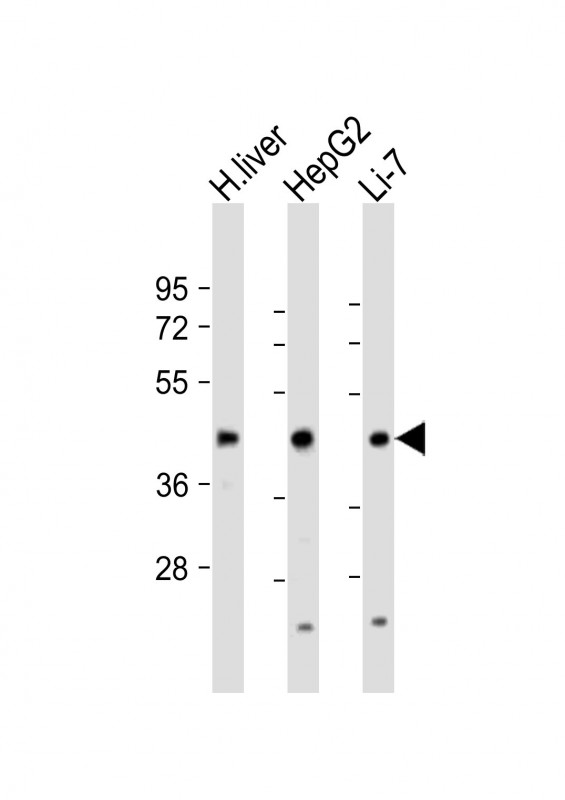CREB3L3 Antibody (Center)
Purified Rabbit Polyclonal Antibody (Pab)
- SPECIFICATION
- CITATIONS
- PROTOCOLS
- BACKGROUND

Application
| WB, E |
|---|---|
| Primary Accession | Q68CJ9 |
| Reactivity | Human |
| Host | Rabbit |
| Clonality | polyclonal |
| Isotype | Rabbit IgG |
| Calculated MW | 49077 Da |
| Gene ID | 84699 |
|---|---|
| Other Names | Cyclic AMP-responsive element-binding protein 3-like protein 3, cAMP-responsive element-binding protein 3-like protein 3, Transcription factor CREB-H, Processed cyclic AMP-responsive element-binding protein 3-like protein 3, CREB3L3, CREBH |
| Target/Specificity | This CREB3L3 antibody is generated from a rabbit immunized with a KLH conjugated synthetic peptide between 244-274 amino acids of human CREB3L3. |
| Dilution | WB~~1:1000-1:2000 E~~Use at an assay dependent concentration. |
| Format | Purified polyclonal antibody supplied in PBS with 0.09% (W/V) sodium azide. This antibody is purified through a protein A column, followed by peptide affinity purification. |
| Storage | Maintain refrigerated at 2-8°C for up to 2 weeks. For long term storage store at -20°C in small aliquots to prevent freeze-thaw cycles. |
| Precautions | CREB3L3 Antibody (Center) is for research use only and not for use in diagnostic or therapeutic procedures. |
| Name | CREB3L3 |
|---|---|
| Synonyms | CREBH |
| Function | Transcription factor that may act during endoplasmic reticulum stress by activating unfolded protein response target genes. Activated in response to cAMP stimulation. In vitro, binds to the cAMP response element (CRE) and box-B element. Activates transcription through box-B element. Activates transcription through CRE (By similarity). May function synergistically with ATF6. In acute inflammatory response, may activate expression of acute phase response (APR) genes. May be involved in growth suppression. Regulates FGF21 transcription (By similarity). Plays a crucial role in the regulation of triglyceride metabolism and is required for the maintenance of normal plasma triglyceride concentrations (PubMed:21666694). |
| Cellular Location | Endoplasmic reticulum membrane; Single-pass type II membrane protein |
| Tissue Location | Exclusively expressed in liver. Underexpressed in hepatocellular carcinoma tissues. |

Thousands of laboratories across the world have published research that depended on the performance of antibodies from Abcepta to advance their research. Check out links to articles that cite our products in major peer-reviewed journals, organized by research category.
info@abcepta.com, and receive a free "I Love Antibodies" mug.
Provided below are standard protocols that you may find useful for product applications.
Background
Transcription factor that may act during endoplasmic reticulum stress by activating unfolded protein response target genes. Activated in response to cAMP stimulation. In vitro, binds to the cAMP response element (CRE) and box-B element. Activates transcription through box-B element. Activates transcription through CRE (By similarity). Seems to function synergistically with ATF6. In acute inflammatory response, may activate expression of acute phase response (APR) genes. May be involved in growth suppression.
References
Omori Y.,et al.Nucleic Acids Res. 29:2154-2162(2001).
Yamada S.,et al.Oncogene 23:5901-5911(2004).
Ota T.,et al.Nat. Genet. 36:40-45(2004).
Grimwood J.,et al.Nature 428:529-535(2004).
Mural R.J.,et al.Submitted (SEP-2005) to the EMBL/GenBank/DDBJ databases.
If you have used an Abcepta product and would like to share how it has performed, please click on the "Submit Review" button and provide the requested information. Our staff will examine and post your review and contact you if needed.
If you have any additional inquiries please email technical services at tech@abcepta.com.













 Foundational characteristics of cancer include proliferation, angiogenesis, migration, evasion of apoptosis, and cellular immortality. Find key markers for these cellular processes and antibodies to detect them.
Foundational characteristics of cancer include proliferation, angiogenesis, migration, evasion of apoptosis, and cellular immortality. Find key markers for these cellular processes and antibodies to detect them. The SUMOplot™ Analysis Program predicts and scores sumoylation sites in your protein. SUMOylation is a post-translational modification involved in various cellular processes, such as nuclear-cytosolic transport, transcriptional regulation, apoptosis, protein stability, response to stress, and progression through the cell cycle.
The SUMOplot™ Analysis Program predicts and scores sumoylation sites in your protein. SUMOylation is a post-translational modification involved in various cellular processes, such as nuclear-cytosolic transport, transcriptional regulation, apoptosis, protein stability, response to stress, and progression through the cell cycle. The Autophagy Receptor Motif Plotter predicts and scores autophagy receptor binding sites in your protein. Identifying proteins connected to this pathway is critical to understanding the role of autophagy in physiological as well as pathological processes such as development, differentiation, neurodegenerative diseases, stress, infection, and cancer.
The Autophagy Receptor Motif Plotter predicts and scores autophagy receptor binding sites in your protein. Identifying proteins connected to this pathway is critical to understanding the role of autophagy in physiological as well as pathological processes such as development, differentiation, neurodegenerative diseases, stress, infection, and cancer.


